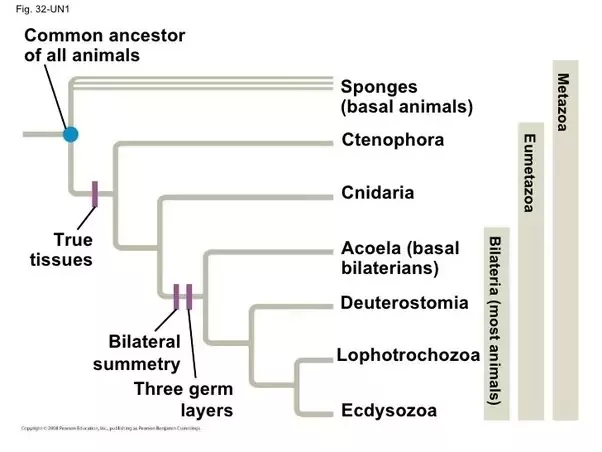Why are sponges considered unique in animal evolution? They are believed to have evolved from a group of flagellates that are completely different from other animals. They are also considered to be evolutionary dead ends. Five Facts About Sponges Early fossil records show that sponges inhabited Earth about 600 million years ago. Some deep-sea sponges are more than 200 years old. The sponge is a master filter. They can filter 100,000 times more water every day! In other words, a.More. They are the least complex of animals and most in common with protists. Their evolutionary relationship derives from phagocytes within the sponge. This is very similar to the choanoflagellate, which seems to be an evolution of the sponge. Unlike choanoflagellates, sponges are multicellular. One of the first multicellular animals, the sponge (Porifera), is a sister group of all other metazoans (Feuda et al., 2017). They are an ancient lineage of morphologically simple animals that diverged from other metazoans at least 700 Mya long before the Cambrian explosion (Simion et al., 2017). Because it is an animal, not a plant. In the animal kingdom, they are horozoic in nature and capture food for eating, they do not have cell walls, their life cycle involves the larval stage. In addition, they are called animals because they are ectodermal and have glycogen as a preserved food.
Sponges are classified as animals because they represent the first transition to the multicellular tissues that characterize the animal kingdom.
What are the interesting facts about sponges?
Sponge was the first animal to evolve from a protist, about 700 million years ago. They are the least complex of animals and most in common with protists.
What is the evolutionary relationship between sponges and protists?
They are the least complex of animals and most in common with protists. Their evolutionary relationship derives from phagocytes within the sponge. This is very similar to the choanoflagellate, which seems to be an evolution of the sponge.
Was the first multicellular animal a sponge?
The sponge may have been the first multicellular animal. Multicellular (meaning that cells attach to each other, communicate with each other, depend on each other for survival, and specialize in performing different tasks) to produce more complex organisms. It is the key of.
Why are sponges animals, not plants?
Sponges are animals, not plants, because they are classified in the phylum of the animal kingdom. Sponges are horozoic in nature, capture and eat food, have no cell walls, and have a life cycle that includes the larval stage. .. In addition, they are called animals because they are ectodermal and have glycogen as a preserved food material.
What makes sponges unique among animals?
What is the unique feature of sponge among other animals? The sponge has no mouth or intestines, is stemless like an adult, and is not organized beyond the cellular level. This animal is composed mainly of a canal system in which flagellar cells called choanocytes pump water.
What is the importance of sponges in animal evolution?
Sponges in particular are often regarded as living agents of early animal ancestry, primarily due to their similarity to phagocytes (choanocytes). Choanoflagellate, a single-cell / colonizing sister colony of animals.
How is the sponge uniquely different from other animals?
Sponges are multicellular, heterotrophic, lack cell walls, and are similar to other animals in that they produce sperm cells. Unlike other animals, they lack real tissues and organs. Some of them are radially symmetric, but most are asymmetric.

Below you will find two helpful answers on a similar topic. 👇
What do I do if my blood pressure is high?What is considered stroke level high blood pressure?
